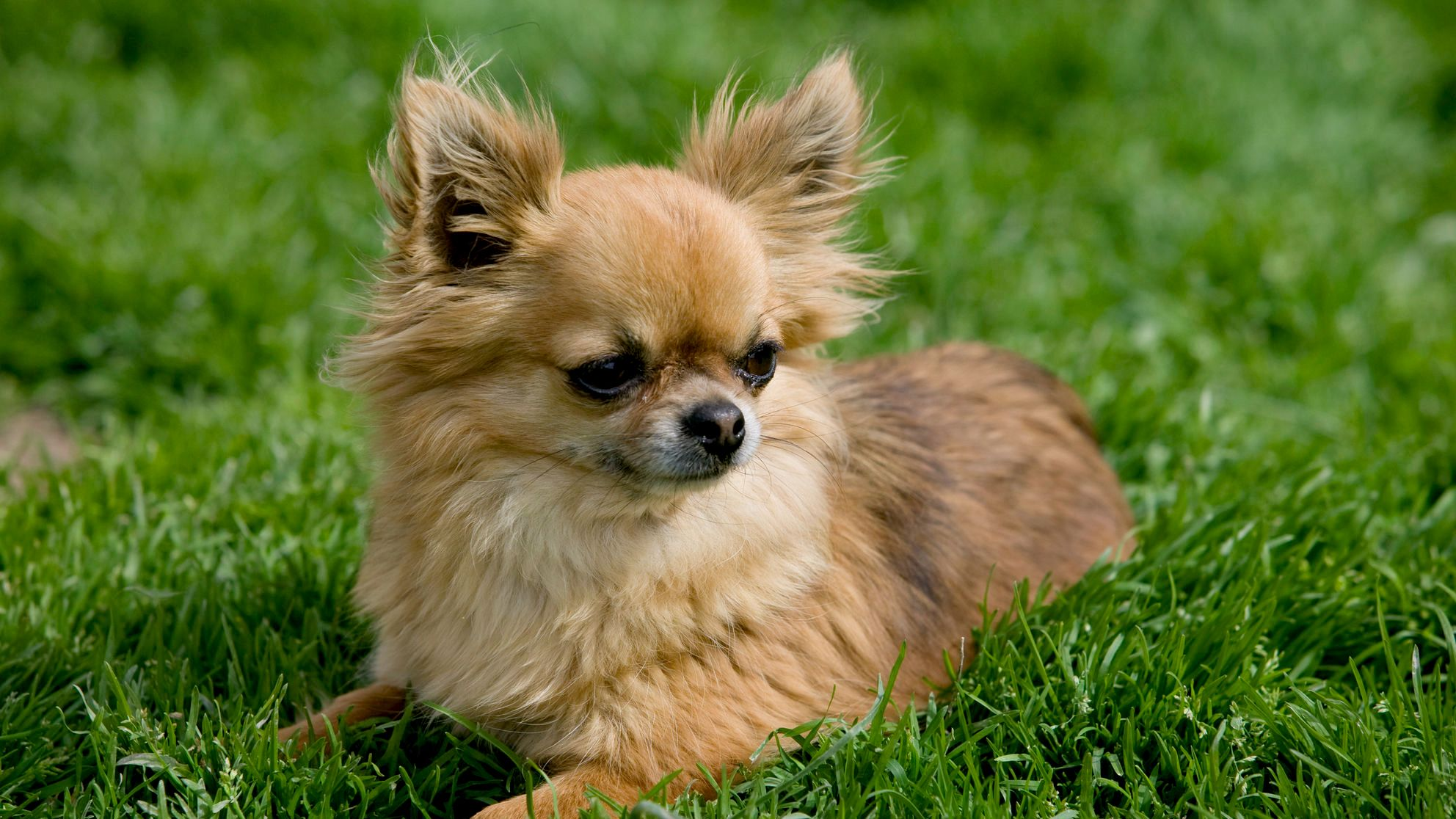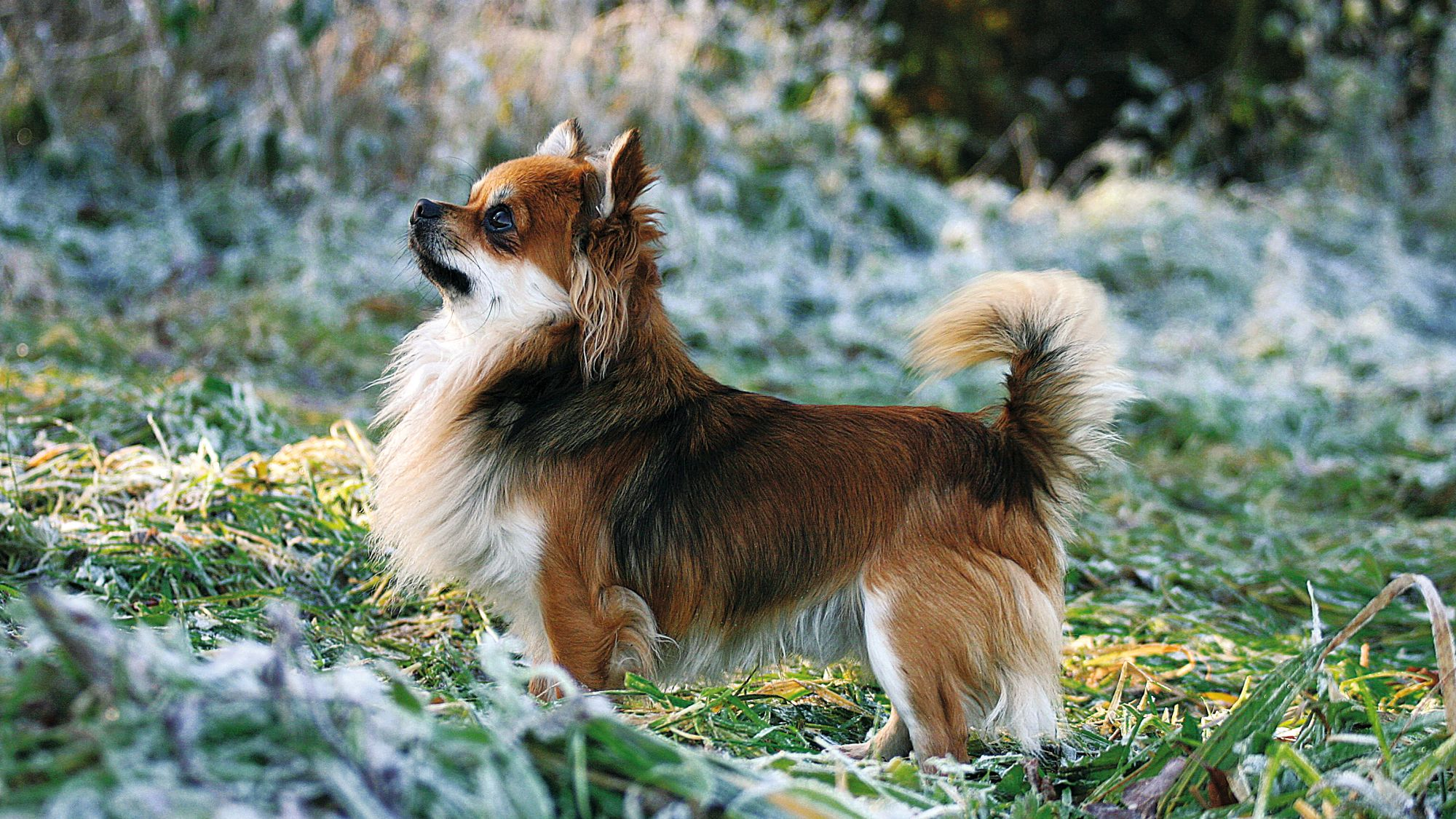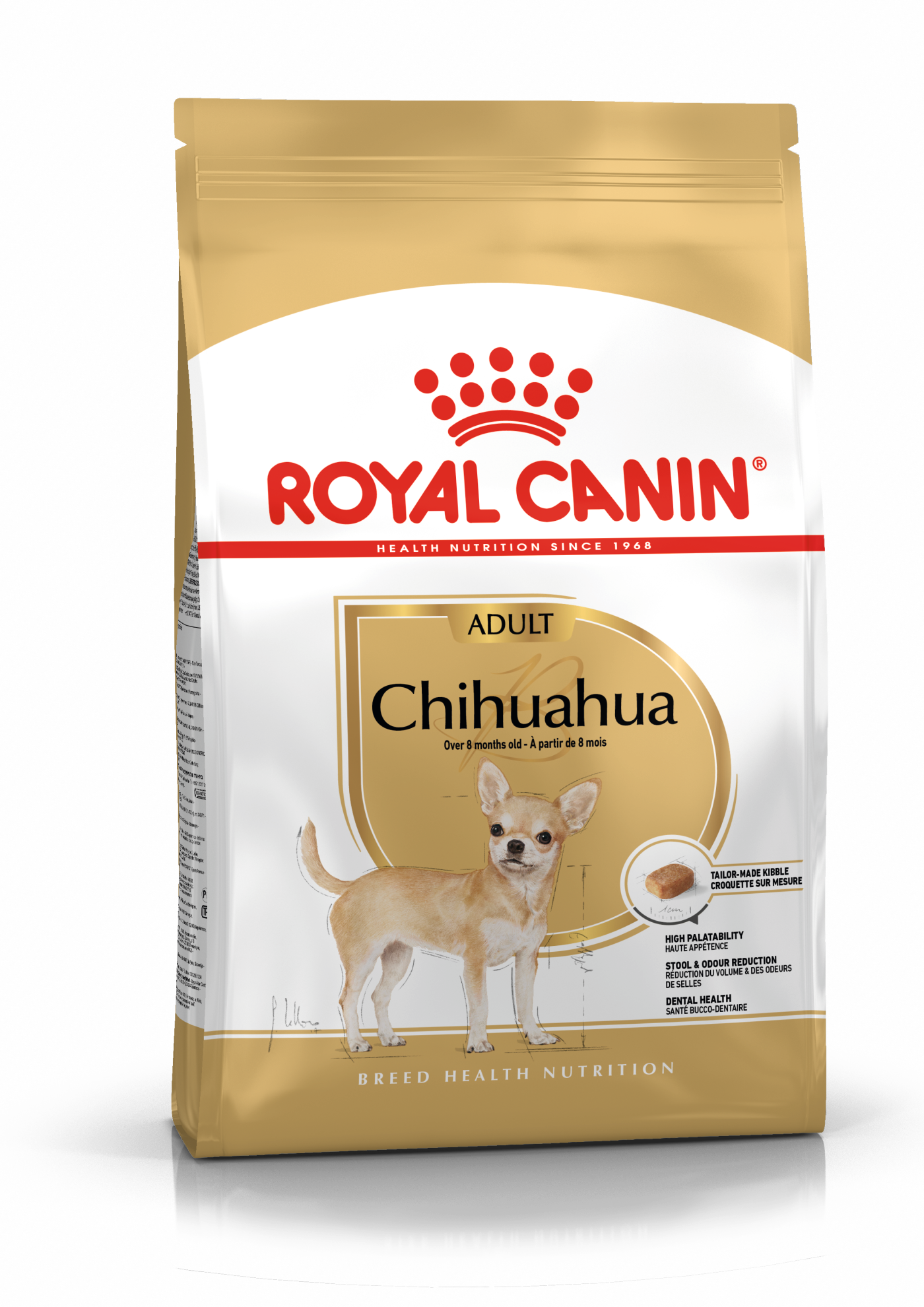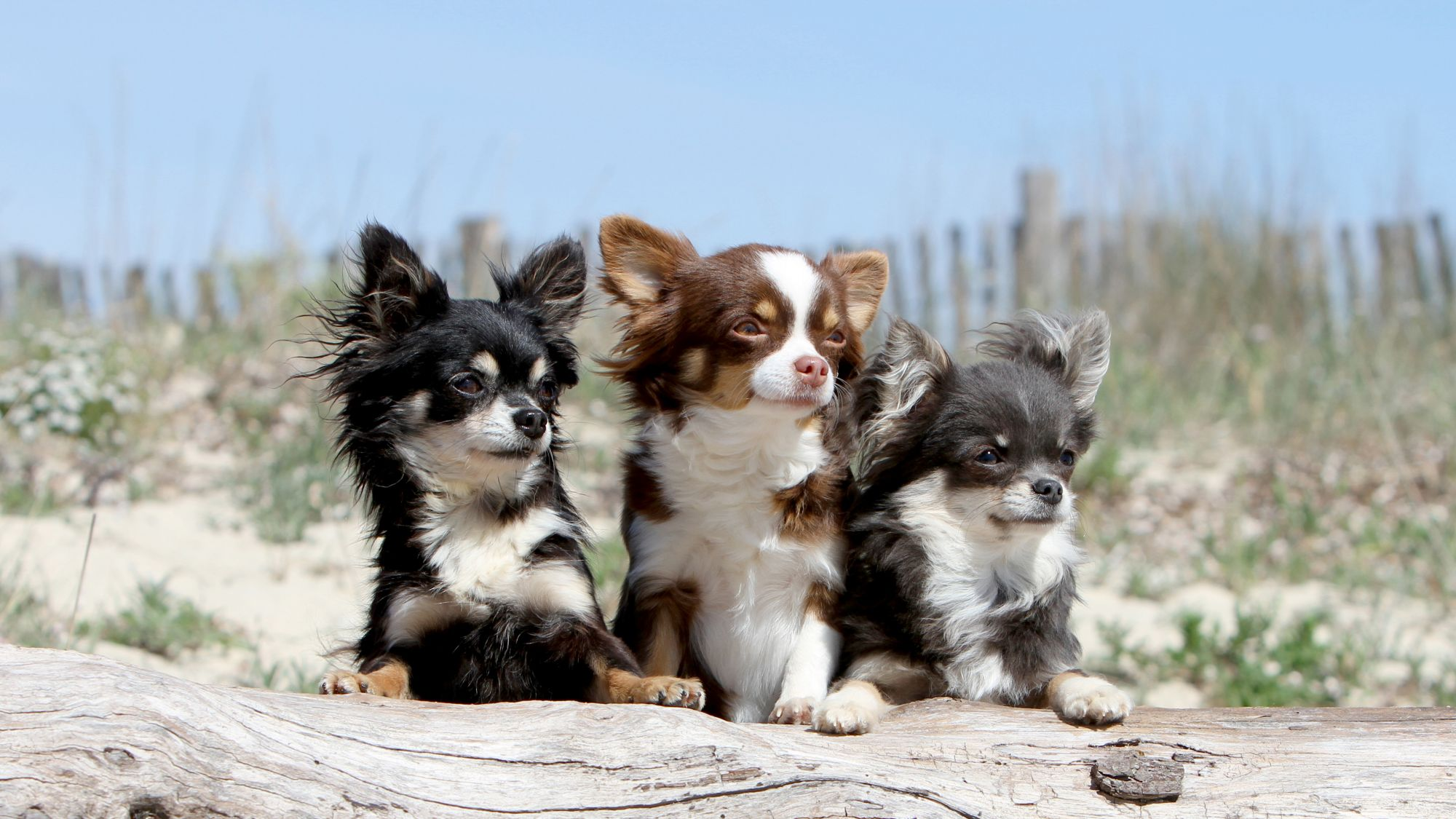Long Haired Chihuahua - Breed Facts & Characteristics
Petite yet mighty, Long-Coat Chihuahuas are the tiniest of breeds yet possess a big heart. Instantly identifiable by their apple-shaped head and doe-eyes, their devoted stare conveys the mammoth warmth found within. Chihuahuas are fiercely loyal, great for city or country homes, and with proper care, live very long healthy lives - often two decades or more. The breed also comes in a smooth-coat version.
Official name: Long-Coat Chihuahua
Other names: Chiwawa, Chi
Origins: Mexico
Drooling tendencies
1 out of 5Grooming needs
3 out of 5Shedding Level
3 out of 5Barking tendencies
2 out of 5Energy level*
3 out of 5Compatibility with other pets
3 out of 5Warm weather?
3 out of 5Cold weather?
1 out of 5Suited to apartment living
5 out of 5Can stay alone
2 out of 5Family pet?*
4 out of 5
| Male | Female |
|---|---|
| Height | Height |
| 12.7 - 22.86 cm | 13 - 20 cm |
| Weight | Weight |
| 1 - 3 kg | 1 - 3 kg |
| Life stages | |
|---|---|
| Puppy | Adult |
| 2 to 10 months | 10 months to 8 years |
| Mature | Senior |
| 8 to 12 years | From 12 years |
| Baby | |
| Birth to 2 months | |
Drooling tendencies
1 out of 5Grooming needs
3 out of 5Shedding Level
3 out of 5Barking tendencies
2 out of 5Energy level*
3 out of 5Compatibility with other pets
3 out of 5Warm weather?
3 out of 5Cold weather?
1 out of 5Suited to apartment living
5 out of 5Can stay alone
2 out of 5Family pet?*
4 out of 5
| Male | Female |
|---|---|
| Height | Height |
| 12.7 - 22.86 cm | 13 - 20 cm |
| Weight | Weight |
| 1 - 3 kg | 1 - 3 kg |
| Life stages | |
|---|---|
| Puppy | Adult |
| 2 to 10 months | 10 months to 8 years |
| Mature | Senior |
| 8 to 12 years | From 12 years |
| Baby | |
| Birth to 2 months | |
Tailored nutrition for your Long-Coat Chihuahua

Get to know Long-Coat Chihuahua
All you need to know about the breed
“Best buddy” is the ideal phrase to describe the Long-Coat Chihuahua, the ideal companion dog. Loyalty is a given for a breed that easily cosies up but is always on alert where their owner is concerned. Barking at strangers may happen with the Chihuahua but it’s hardly cause for concern. They’ll soon be diverted by another nonstop activity. Playtime is anytime as far as they’re concerned!
The power-packed personality of the Chihuahua breed is evident in their official ranking: They currently hold 11th place on the American Kennel Club’s annual list of most popular breeds.
The breed never grows past 3 kilograms - 6 pounds - so taking them pretty much anywhere is doable.
When it comes to dogs, we’re often advised to watch children for fear that the dog may hurt them unwittingly. But because this breed is so small, children are the ones who could actually harm the Chihuahua without meaning to. They can be fragile so keep a watchful eye. Indoor play is ideal as are small dog parks. Mental stimulation is great for the Chihuahua breed, and games are an ideal pastime, too.
Far from being a hulking security dog, Chihuahuas can be just as protective of their flock. They tend to be reserved with strangers, but this wariness falls away once a new relationship is formed.

2 facts about Long-Coat Chihuahuas
1. Don’t spoil them too rotten
Believe it or not, Long-Coat Chihuahuas can gain weight easily. With a small body, one too many snacks can quickly add up. Use a handful of kibble as a treat, taken from their daily meal allocation. The official breed classification puts the Chihuahua at six pounds, tops.
2. So small in a big world
The Chihuahua personality is a bold one for sure: not to be dismissed, they've been known to challenge dogs multiple times their size. Teaching your new dog a new trick - how to get along with others - will be key to proper socialising as they grow.
History of the breed
Many wonder where the diminutive Chihuahua comes from. The dog hails from 12th-Century Mexico during the time the Aztecs conquered the Toltec civilisation, and the Techichi dog, a denser ancestor of the Chihuahua breed. The Techichi was lighter and more agile than the current Chihuahua size, if that’s even possible for such a petite breed of dog.
Throughout the centuries, the Chihuahua persevered, eventually gaining huge popularity in the U.S. in the mid-1800s when Americans discovered them in their area of origin, Chihuahua, the Mexican state that borders Texas. The Techichi was then renamed and the Chihuahua breed flourished north of the border.
Long-Coat Chihuahuas can be clannish, tending to stick with their own kind. Not bred for a particular job, Chihuahuas function best as a family dog and of course make a superb travelling partner. For that, they’re just the right size: the Chihuahua dog breed is considered the smallest in the world, maxing out at just over 6 pounds, or 2.2 kilos.
From head to tail
Physical characteristics of Long-Coat Chihuahuas
1.Ears
2.Head
3.Body
4.Fur
5.Tail

Things to look out for
From specific breed traits to a general health overview, here are some interesting facts about your Long-Coat Chihuahua
This is one dogged dog
The headstrong Long-Coat Chihuahua temperament and willful determination is surprising, given their compact size. But small can still mean mighty when it comes to getting their way. The Long-Coat Chihuahua is smart and will outsmart you if you let him! The solution: Train your dog from an early age, rewarding good behaviour and ignoring the behaviour that you don't want to see. Training your Long-Coat Chihuahua well can offset any tenacious streak they may have and instill good behaviour.
Too much exercise could wear them out
The Chihuahua breed is a high-energy one for sure, but don’t mistake this characteristic for your Long-Coat Chihuahua’s desire to take super long walks or play endlessly, although some Chihuahua's may surprise you. A small body means that less is more. Indoor activity on a daily basis is stimulating for the Long-Coat Chihuahua dog, and they’ll get plenty of enjoyment out of outdoor activities as well. And as with all smaller dogs, if they get too tired, you can just pick them up and put them in a carrier the rest of the way home!
Chihuahuas can have a few health issues
Small dog breeds can be prone to hypoglycemia, or low blood sugar. It’s easy to think that the Long-Coat Chihuahuas’ little bodies don’t need a lot to go on but too-long a stretch between meals and your dog may have a serious dip in energy. Stick to a regular meal schedule and feeding guidelines on food packaging. The breed can also occasionally have cardiac concerns such as narrow heart valves or atrioventricular valve disease, or potential heart valve problems, eye disease, and patellar luxation, or loose kneecaps. Regular vet checkups can stem any problems before they start.
Healthy diet, healthier dog

When choosing food for a Chihuahua, there are many factors to consider: their age, lifestyle, activity level, physiological condition, and health including potential sickness or sensitivities. Food provides energy to cover a dog’s vital functions, and a complete nutritional formula should contain an adjusted balance of nutrients to avoid any deficiency or excess in their diet, both of which could have adverse effects on the dog. The following recommendations are for healthy animals. If your dog has health problems, please consult your veterinarian who will prescribe an exclusive veterinary diet. Clean and fresh water should be available at all times to support your dog’s urinary health. In hot weather and especially when out exercising, bring water along for your dog’s frequent water breaks.
A Chihuahua puppy’s requirements, in terms of energy, protein, minerals, and vitamins, are much greater than those of an adult dog. They need energy and nutrients to maintain their body, but also to grow and build it. Until they are 8 months old, a Chihuahua puppies’ immune system develops gradually. A complex of antioxidants - including vitamin E - can help support their natural defences during this time of big changes, discoveries, and new encounters. Their digestive functions are different from an adult Chihuahua’s, too: their digestive system is not mature yet so it’s important to provide highly digestible proteins that will be effectively used. A balanced intake of fibres, such as psyllium, can help facilitate intestinal transit and contribute to good stool quality.
Similarly, a puppy’s teeth – starting with the milk teeth, or first teeth, then the permanent teeth – are an important factor that needs to be taken into account when choosing the size, form, and hardness of kibble. This growth phase also means high energy needs, so the food must have a high energy content (expressed in Kcal/100g of food), while concentrations of all other nutrients will also be higher than normal in a specially formulated growth food. It is recommended to split the daily allowance into three meals a day until they are six months old, then to switch to two meals per day.

The main nutritional goals for adult Chihuahuas are:
Maintaining an ideal body weight by using highly digestible ingredients and keeping the fat content at a sensible level
Preserving the health and beauty of the skin and coat with the enriched provision of essential fatty acids (especially EPA-DHA), essential amino acids, and B vitamins.
Supporting their very delicate jaws. Chihuahuas have a strong predisposition to accumulating dental tartar. By reducing tartar formation on the teeth, which is responsible for dental plaque, kibble containing calcium chelators plays an essential role and helps combat oral disorders. The size and shape of the kibble should be very small and adapted to the miniature jaw of Chihuahuas in order to avoid problems with picking up food. This may also stimulate their fussy appetite.
For Chihuahuas living mainly indoors and because of their reduced activity, it is important to avoid feeding them human foods or fatty snacks and to strictly follow the feeding guidelines written on the package. It is particularly important to do this after neutering as this can lead to excessive weight gain.
To reduce faecal smell and volume, look for a diet formulated with highly digestible proteins, an appropriate fibre content, and very high quality carbohydrate sources for maintaining healthy intestines and healthy stools.
A diet that also helps support a healthy urinary system is recommended to prevent urinary stones.

After 8 years old, Chihuahuas start facing the first signs of ageing. A diet enriched with antioxidants helps maintain vitality, and key nutrients, such as taurine,help support healthy heart function. Ageing can also impact digestive capabilities and particular nutritional requirements, so food for ageing Chihuahuas should have the following characteristics:
Higher vitamin C and E content. These nutrients have antioxidant properties, supporting the body’s cells against the harmful effects of the oxidative stress linked to ageing.
High-quality protein. Contrary to a widely held misconception, lowering the protein content in food brings little benefit in limiting kidney failure because older dogs are less efficient at using dietary protein than younger dogs. Reducing the phosphorus content is the only way of slowing down the gradual deterioration of kidney function.
A higher proportion of the trace elements iron, zinc and manganese to maintain good condition of the skin and coat.
A higher quantity of polyunsaturated fatty acids (borage oil, fish oil) to maintain the quality of the coat. Dogs normally produce these fatty acids, but ageing can affect this physiological process.
As they age, dogs increasingly suffer from teeth problems. To ensure they continue to eat in sufficient quantities, the shape, size, and hardness of their kibble needs to be tailored to their jaw. A formula that contains calcium chelators will support dental health by reducing tartar formation.
Although important throughout the Chihuahua’s life, heart health becomes more important as the dog ages. A blend of nutrients, such as taurine and EPA-DHA, will help maintain cardiac health in mature Chihuahuas.

Caring for your Long-Coat Chihuahua
Grooming, training and exercise tips
There is plenty of activity the Long-Coat Chihuahua can get up to every day. Like any dog, they need moderate exercise to keep in good health. Short jaunts around a few blocks or a good run in the park will work to keep them in good shape. The life expectancy of the Chihuahua is a long one; keep them fit all those years with appropriate activity, like simple play indoors and fun games of fetch.
The flowing tresses of the Long-Coat Chihuahua is a sight to behold. Keep their coat in shape by grooming it two to three times per week; doing so will help to avoid any tangles or mats, and don’t neglect the fringed hair on their ears, legs, and feet as well. Shedding is luckily not an issue for the breed. Routine nail trims should be maintained as should the regular brushing of teeth to stave off any periodontal problems.
The devoted, smart Long-Coat Chihuahua is a delightful dog to have around. An intense loyalty means they’re motivated to please, and will definitely respond well to obedience training. Instilling good habits in your Long-Coat Chihuahua from a young age will yield the best results and curb the tendency to be overly assertive.
There is plenty of activity the Long-Coat Chihuahua can get up to every day. Like any dog, they need moderate exercise to keep in good health. Short jaunts around a few blocks or a good run in the park will work to keep them in good shape. The life expectancy of the Chihuahua is a long one; keep them fit all those years with appropriate activity, like simple play indoors and fun games of fetch.
The flowing tresses of the Long-Coat Chihuahua is a sight to behold. Keep their coat in shape by grooming it two to three times per week; doing so will help to avoid any tangles or mats, and don’t neglect the fringed hair on their ears, legs, and feet as well. Shedding is luckily not an issue for the breed. Routine nail trims should be maintained as should the regular brushing of teeth to stave off any periodontal problems.
The devoted, smart Long-Coat Chihuahua is a delightful dog to have around. An intense loyalty means they’re motivated to please, and will definitely respond well to obedience training. Instilling good habits in your Long-Coat Chihuahua from a young age will yield the best results and curb the tendency to be overly assertive.
7/7
All about Long-Coat Chihuahuas
The Long-Coat Chihuahua has all the makings of a great pet: a fun temperament, high energy, and affection in large doses. The Chihuahua breed is also great for those new to dog ownership. Let’s face it, there’s not a lot of dog there to handle! Loyalty is a given for the Long-Coat Chihuahua and their size makes for great portability as well.
Long-Coat Chihuahuas are not naturally aggressive; if they bark or snap it’s just that - like any dog - their bark at times may be worse than their bite. They could be territorial or anxious, and the breed can also be possessive of their owner. Even though they’re petite, the behaviour shouldn’t be classified as cute; it requires training, and doing so will actually help your Long-Coat Chihuahua feel comfortable. Rule out any underlying medical conditions as well that may be spurring on their anxiety.
Other breeds that might interest you
Read more on this topic
Sources
- Veterinary Centers of America https://vcahospitals.com/
- Royal Canin Dog Encyclopaedia. Ed 2010 and 2020
- Banfield Pet Hospital https://www.banfield.com/
- Royal Canin BHN Product Book
- American Kennel Club https://www.akc.org/
Like & share this page